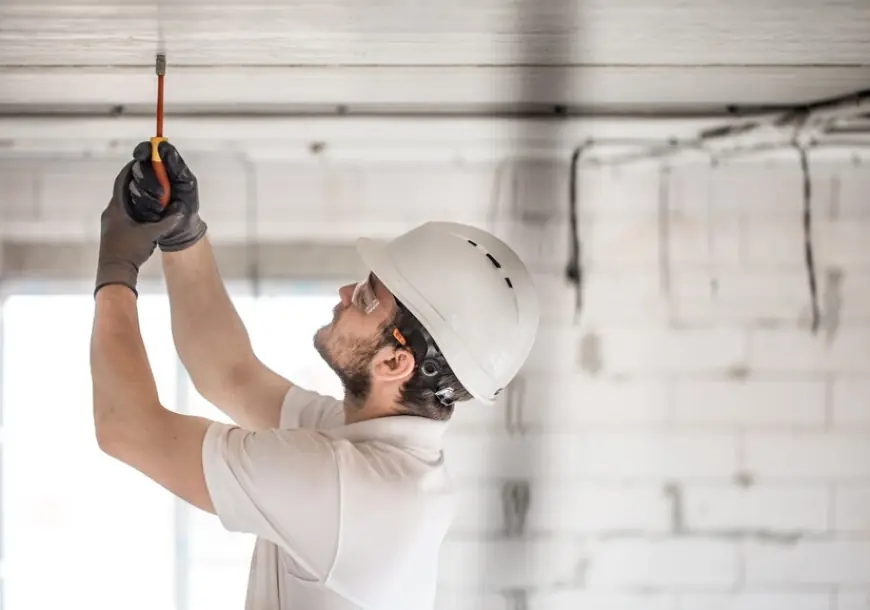Step-by-Step: How to Repair Ceiling Drywall Quickly
Learn how to repair ceiling drywall quickly with this step-by-step guide. Fix cracks, holes, and stains easily with simple tools and techniques.
Have you spotted a crack, hole, or stain on your ceiling? Don’t worry—it’s not as hard to fix as it looks. Whether the damage is from a leak, an accident, or just regular wear and tear, you can repair your ceiling drywall at home. This guide will teach you how to repair ceiling drywall step by step, using easy tools and methods. Let’s get started and make your ceiling look as good as new!
What Causes Ceiling Damage?
Before jumping into repairs, it’s helpful to know what might have caused the problem.
-
Water Leaks:
-
Plumbing or roof leaks often create weak spots, stains, or sagging.
-
Fix the leak before repairing the drywall to avoid future damage.
-
Accidents:
-
Did you accidentally bump the ceiling with furniture or tools? It happens!
-
Even small bumps can create cracks or holes.
-
Age and Settling:
-
Over time, homes settle, and drywall can crack or shift.
-
This is normal but can make your ceiling look old.
Signs Your Ceiling Needs Repair
Here’s how to know it’s time to take action:
-
Cracks running across the surface
-
Bulging or sagging spots
-
Holes of any size
-
Yellow or brown water stains
Ignoring these issues can lead to bigger problems later, so it’s best to fix them early.
Tools and Materials You’ll Need
Before you start, gather these tools. Having everything ready will save you time!
-
Utility knife
-
Drywall saw
-
Drywall patch or sheet
-
Joint compound
-
Drywall tape
-
Sandpaper (medium and fine grit)
-
Paint primer and matching paint
-
Screwdriver
-
Drop cloths or plastic sheets
Step 1: Prepare Your Space
Preparation is key for a smooth repair job.
-
Clear the Area:
Move furniture and cover the floor with a drop cloth to catch dust and debris. -
Inspect the Damage:
Look closely at the damaged area. Is it just a crack, or is there a hole? -
Remove Loose Material:
Use a scraper to remove flaking paint or broken drywall.
Step 2: Cut Out the Damaged Area
For holes or large cracks, you’ll need to cut out the damaged drywall.
-
Mark the Area:
Use a pencil and ruler to draw a square or rectangle around the damage. -
Cut It Out:
Carefully cut along the lines with a utility knife or drywall saw. -
Check the Frame:
If the hole exposes wooden studs, make sure they’re sturdy. Weak studs may need reinforcement.
Step 3: Attach the Drywall Patch
Now it’s time to fill the hole!
-
Measure and Cut:
Cut a new piece of drywall slightly smaller than the hole. -
Secure the Patch:
Screw the patch into the wooden studs using drywall screws. If the hole is small, use adhesive drywall tape to hold the patch in place.
Step 4: Apply Joint Compound
This step hides the patch and blends it into the rest of the ceiling.
-
Spread the Compound:
Use a drywall knife to apply joint compound over the patch and the edges. -
Add Drywall Tape:
Press tape into the compound to hold it steady. Smooth another layer of compound over the tape. -
Let It Dry:
Drying takes a few hours. Don’t rush—wet compounds are harder to work with. -
Sand It Smooth:
Once dry, sand the area until it feels level with the rest of the ceiling.
Step 5: Prime and Paint
Your ceiling repair isn’t complete without a fresh coat of paint.
-
Apply Primer:
Primer helps the paint stick and hides any stains. -
Paint the Area:
Match the color to your existing ceiling. Use a roller for large areas and a brush for edges. -
Second Coat:
For the best results, apply a second coat once the first one dries.
Pro Tips for Ceiling Repairs
Here are some extra tips to make the job easier:
-
Work Safely:
Always use a sturdy ladder and wear a dust mask to protect yourself. -
Use Thin Layers:
Apply joint compound in thin layers to avoid lumps or bubbles. -
Feather the Edges:
Spread the compound beyond the patch to make it blend with the ceiling. -
Check for Leaks First:
If water damage causes the problem, fix the leak before repairing the drywall.
Benefits of DIY Ceiling Repairs
Fixing your ceiling yourself has many benefits:
-
Saves Money:
A DIY repair costs much less than hiring a contractor. -
Quick Results:
Small repairs can be done in a single afternoon. -
Boosts Confidence:
There’s nothing like the satisfaction of fixing your own home!
Frequently Asked Questions (FAQs)
Q1. What’s the easiest way to repair a small hole in the ceiling?
A: Use a pre-made drywall patch kit. These kits come with everything you need and are perfect for small holes.
Q2. How do I know if my drywall is too damaged to repair?
A: If the damage covers a large area or the drywall feels soft, you might need to replace the whole panel.
Q3. How often should I repaint my ceiling?
A: Ceilings usually need repainting every 5–10 years or when repairs are made.
Conclusion
Repairing ceiling drywall doesn’t have to be hard or scary. With this guide, you now know how to repair ceiling drywall step by step. From preparing your space to painting the final coat, you can handle it all like a pro!
If you need help or want expert advice, contact Eagleriver Painters today. We’re here to make your home repairs simple and stress-free!

 eagleriverpainte
eagleriverpainte 











